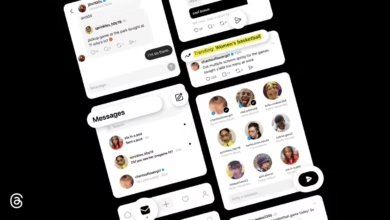Evolving News: Digital Shifts, AI, and Trust Challenges (Q & A)

How is news consumption evolving globally, particularly with the rise of social media and video platforms?
Traditional news media sources, such as TV, print, and news websites, are experiencing a continuous decline in engagement across most countries. Concurrently, there’s a growing dependence on social media, video platforms, and online aggregators for news. This shift is particularly pronounced in the United States, where social media news use saw a significant increase.
Globally, six online networks now reach over 10% weekly with news content, compared to only two a decade ago. Facebook (36%) and YouTube (30%) are used by about a third of the global sample for news, while Instagram (19%), WhatsApp (19%), and TikTok (16%) also hold significant shares. TikTok is noted as the fastest-growing social and video network for news. This trend is further fueled by changing platform strategies that prioritize video content, leading to a rise in social video consumption from 52% in 2020 to 65% in 2025. This shift also encourages the growth of personality-led news creators, especially in countries like the Philippines, Thailand, Kenya, and India, where more people prefer watching news over reading it.
What is the role of alternative media ecosystems, including YouTubers, TikTokers, and podcasters, in shaping public discourse?
An alternative media ecosystem, encompassing YouTubers, TikTokers, and podcasters, is significantly influencing public debates, particularly evident in the US and global majority countries where social media is widely used for news. These alternative voices often have extensive reach and appeal to audiences that traditional news publishers struggle to engage. For instance, in the US, 22% of the sample encountered news or commentary from popular podcaster Joe Rogan, especially young men. In France, young news creator Hugo Travers (HugoDécrypte) reaches 22% of under-35s primarily via YouTube and TikTok.
Similarly, influential TikTokers in Thailand, like Anuwat Noom and Phakkawat Rattanasiriampai, have amassed millions of followers for their concise and accessible news takes. While offering fresh perspectives and challenging established narratives, this ecosystem also poses threats; online influencers and personalities are perceived as the biggest source of false or misleading information worldwide (47%), on par with national politicians. This blurring of lines between journalism, activism, and politics, as seen with figures like Călin Georgescu in Romania, contributes to rising political polarization and a coarsening of online debate.
What are the public’s concerns regarding misinformation and disinformation online, and how do they verify information?
Over half of the global survey sample (58%) express concern about distinguishing true from false information online, a figure consistent with the previous year and higher than in 2022. This concern is highest in Africa and the United States (both 73%) and lowest in Western Europe (46%). Online influencers and personalities, along with national politicians, are seen as the biggest threats for spreading false or misleading information (both at 47%). Facebook and TikTok are identified as the platforms posing the greatest threat in terms of misinformation spread.
Despite these concerns, when seeking to verify information they suspect to be false, a significant proportion of respondents (38%) first turn to news outlets they trust, followed by official sources (35%), and fact-checkers (25%), rather than social media (14%). Younger users, however, are more likely to use social media (including reading comments) and AI chatbots for verification. This suggests that while traditional trusted sources remain important for verification, younger generations employ a “flatter” trust pattern, gathering information without a strict hierarchy of validation.
How do audiences perceive AI in news, particularly regarding personalization and content creation?
Audiences hold mixed and generally skeptical views on the use of AI in news, especially regarding automated content production. While a small percentage (7% weekly) currently use AI chatbots for news, this figure rises to 15% among under-25s. When it comes to AI-driven personalization, interest is highest for features that make news consumption quicker and easier, such as summarized versions of articles (27%) and translations (24%). There is less interest in AI chatbots for answering news questions (18%).
Overall, a majority (66%) are interested in at least one AI personalization option. However, audiences are more comfortable with AI being used in a supportive role for journalists (e.g., research, transcription) rather than for primarily generating news content with minimal human oversight. They anticipate AI will make news cheaper (+29 net difference) and more up-to-date (+16), but less transparent (-8), less accurate (-8), and less trustworthy (-18). This skepticism is more pronounced in Europe compared to Asia, where comfort levels with AI in news are generally higher.
What is the current state of news podcasting, and what are the opportunities for publishers to monetize audio content?
News podcasting is an increasingly important format, particularly in reaching younger, better-educated audiences. The United States has the highest proportion of weekly news podcast consumers (15%), with many shows now being filmed and distributed via video platforms like YouTube and TikTok. In contrast, many Northern European podcast markets are dominated by public broadcasters and legacy media, with slower adoption of video versions.
While news podcast consumption remains a niche activity (2% consider it their main source of news across 20 markets), it plays a complementary role in people’s news diets. Its appeal lies in its ability to offer deep analysis and insights, with 73% of listeners saying podcasts help them understand issues more deeply. This habitual listening and strong connection to hosts present monetization opportunities. Around 42% of news podcast listeners across 20 countries are willing to pay a reasonable price for news-related podcasts they like. Publishers are experimenting with ad-supported models, including podcasts in broader subscription bundles (e.g., New York Times’ 40+ shows, The Economist’s Podcast+), and offering premium content like early access or exclusive episodes.
What challenges do local news publishers face in a platform-dominated world, and what strategies are being explored for their value?
Local news publishers are grappling with significant challenges, including declining print circulation, competition from digital platforms, and audiences finding alternative, more efficient ways to access local information. While people remain interested in local news, they increasingly turn to platforms or specialist apps for information on local activities, culture, services (like weather and transport), and buying/selling.
Traditional news media are still considered the best source for local politics, news stories (crime, accidents), and notices (obituaries). This means local media are losing their historical monopoly over certain types of commoditized information. To adapt, local publishers are encouraged to recognize the centrality of platforms and, in some cases, to prioritize direct connection with audiences, especially where platformization is low. Strategies include investing in high-quality, unique, digital content that audiences value and are willing to pay for, often summarized as “publish less, but publish better.” Bundling news with lifestyle content, repackaging different titles and formats, and flexible payment options are also being explored to attract subscribers and diversify revenue streams.
How has the shift to smartphones impacted news consumption habits and the distribution of news alerts?
The smartphone has solidified its position as the primary device for accessing news, fundamentally altering consumption habits. It has eclipsed traditional sources like radio and television as the first way people encounter news in the morning, especially among younger demographics who are “smartphone-first.” This shift has led to increased reliance on social media, mobile notifications, and aggregators for news consumption. Mobile alerts, closely linked to news websites and apps, have become one of the most effective ways for publishers to build direct, deeper connections with existing users, driving habit and loyalty.
Approximately 21% of users globally use news alerts weekly as a starting point for their news journey. Trusted news brands with a reputation for breaking news, particularly public broadcasters like BBC News, perform well with alerts. However, a significant proportion (79%) either never receive alerts or disable them due to feeling overwhelmed, finding them irrelevant, or being disheartened by the news content. Publishers face the challenge of sending timely and relevant alerts without causing “notification overload” or resorting to clickbait.
What are the financial and regulatory pressures facing news media industries across different countries?
News media industries globally face acute financial and regulatory pressures. Economically, they are grappling with declining traditional advertising revenues, increasingly captured by major international platforms like Google and Meta. This has led to widespread financial difficulties, job cuts, and restructuring across print and broadcast sectors, with many struggling to achieve profitability. In response, publishers are focusing on digital monetization, including paywalls and subscriptions, though willingness to pay for online news remains low in many markets (e.g., only 18% across 20 richer countries). Some countries are exploring new revenue streams, such as government subsidies for journalism (e.g., Denmark, Canada) or seeking legal action against tech giants for unauthorized content use (e.g., Canada, South Korea).
Regulatory environments vary, with some governments imposing stricter controls on online content and media (e.g., Hong Kong, Indonesia, Turkey), sometimes under the guise of national security or combating misinformation. This has led to concerns about press freedom, increased surveillance, and self-censorship. In other regions, there’s a push for greater transparency in media ownership and state advertising. Debates surrounding public service broadcasters’ funding and independence are also common (e.g., Austria, Germany, Switzerland). The rise of AI in news has further complicated the regulatory landscape, prompting discussions around copyright, ethical guidelines, and transparency in AI-generated content.




